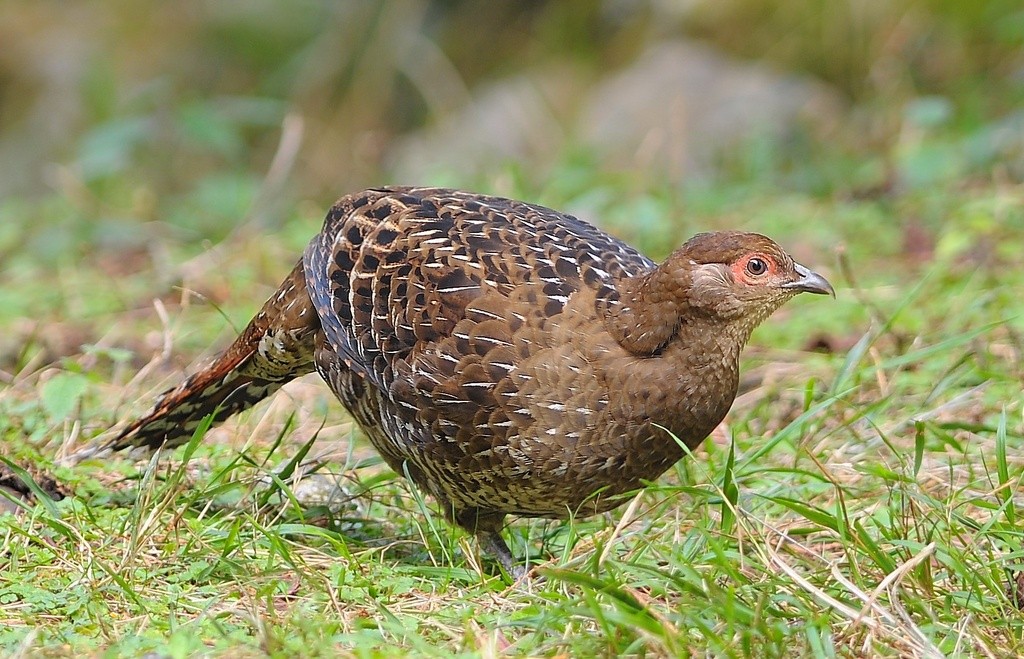Mikado Pheasant
A species of Long-tailed pheasants Scientific name : Syrmaticus mikado Genus : Long-tailed pheasants
Mikado Pheasant, A species of Long-tailed pheasants
Botanical name: Syrmaticus mikado
Genus: Long-tailed pheasants
Content
Description General Info
 Photo By Robert tdc , used under CC-BY-SA-2.0 /Cropped and compressed from original
Photo By Robert tdc , used under CC-BY-SA-2.0 /Cropped and compressed from original Description
With the tail included, males of this species get to be up to 70 cm in body length, while the smaller females measure up to 47 cm. The male is dark with plumage that refracts with blue or violet iridescence, with white stripes on its wings and tail. The female is brown and speckled with brown and white quills. The long and striped tail feathers of the male were used by the Taiwanese aborigines as a head-dress decoration. The type specimen of the pheasant comprises two such tail feathers obtained in 1906 by collector Walter Goodfellow from the head-dress of one of his porters. It was named in honour of the Emperor of Japan, of which Taiwan was occupied by. Its Chinese name, 帝雉 (dìzhì) also translates to "Emperor's Pheasant." 
Size
87 cm
Life Expectancy
6 years
Nest Placement
Ground
Feeding Habits
Mikado Pheasant exhibits a varied diet, foraging primarily for fruit, leaves, vegetation, seeds, and invertebrates. Mikado Pheasant searches for food on the forest floor and mountain paths, displaying behaviors akin to chickens, often during rainy or foggy conditions.
Habitat
Mikado Pheasant's habitat encompasses montane forests, ranging from subtropical to temperate zones. Primarily dwelling in underbrush thickets, including bamboo and rhododendron, mikado Pheasant adapts well to dense vegetation and mixed forest environments. The bird's elevation range typically spans from 1600 to 3300 meters, with a preference for areas with a coniferous canopy providing overhead cover. Broadly, the species is confined to higher elevations within East Asian mountain regions.
Dite type
Granivorous
General Info
Feeding Habits
Bird food type
Behavior
The pheasants will often come out into the open either in light rain or after heavy rain, where the mist conceals them. They tend to be solitary or found in pairs, often quiet, yet alert. They can usually tolerate the presence of humans and it is possible to observe them up close, especially in areas where they have become habituated to humans feeding them. When disturbed, they will slowly and cautiously seek out shelter within surrounding vegetation, rather than fluttering away in panic. If desperate, they will fly short distances, gliding down the mountainside. The males are territorial, with a range of 200–400 metres in radius. Both sexes make soft clucking sounds when feeding, and the males make ke, ke, ke calls when fighting for their mate or territory. Both sexes may perform a wing-whirring display, and during the breeding season the male performs a lateral running display with his body expanded and tail fanned. 
Distribution Area
The Mikado pheasant is endemic to mountainous regions of Taiwan. The species occupies dense shrubs, bamboo growth and grassy terrain with conifer overstory in central and southern Taiwan, from 2000 to 3200 meters above sea level. 
Species Status
There are some Mikado pheasants bred in captivity, but there are only about 10,000 individuals in the wild, particularly in the Yushan National Park. Heavy hunting pressure was a problem in the past, but is not a serious threat today. The Mikado pheasant is evaluated as near threatened on the IUCN Red List of Threatened Species. It is listed on Appendix I of CITES. 